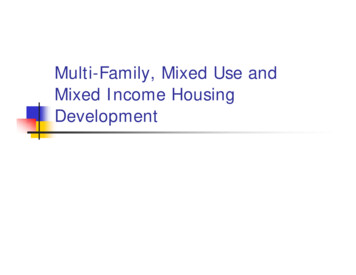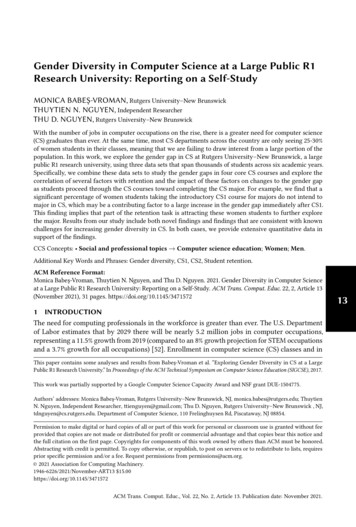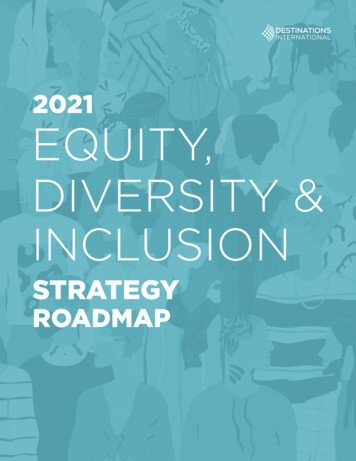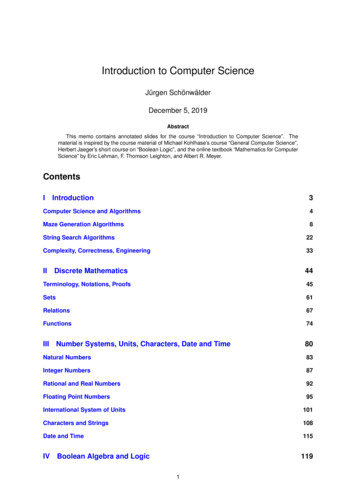
Transcription
Diversity Gaps in Computer Science:Exploring the Underrepresentation of Girls, Blacks and Hispanics2016
2Diversity Gaps in Computer Science:Exploring the Underrepresentation of Girls,Blacks and Hispanics2016Table of ContentsForeword 3Executive Summary 4Introduction 6Computer Science Learning 7Exposure to Technology 11Interest and Confidence in LearningComputer Science 15Views of Computer Science 18Perceived Reasons for Underrepresentation ofCertain Groups in Computer Science 23Conclusion 27About Google 28About Gallup 29Appendix A: Methods 29Appendix B: Full Results 31Suggested citation: Google Inc. & Gallup Inc. (2016). Diversity Gaps in ComputerScience: Exploring the Underrepresentation of Girls, Blacks and Hispanics. Retrievedfrom http://goo.gl/PG34aH. Additional reports from Google’s Computer ScienceEducation Research are available at g.co/cseduresearch.
Diversity 3Gaps in Computer Science: Exploring the Underrepresentation of Girls, Blacks and HispanicsForewordThe Diversity Gaps in Computer Science: Exploring the Underrepresentation of Girls, Blacks, and Hispanics reportis essential given the announcement of President Obama’s bold new initiative, CS for All, in January ofthis year (2016). The report contains the needed focus on women, Blacks, and Hispanics — three groupsthat are underrepresented in computer science studies and the computing workforce. The report raisesawareness about the structural and social barriers for the target groups in computer science, based upon aholistic assessment — surveying students, parents, teachers, principals, and superintendents.As I read the report, the major findings struck a personal chord with me as a Black woman in the field ofcomputer science. When I was in high school, we did not have personal computers or cellphones. My initialinterest in computer science was the result of a class that I was fortunate to have access to in high school. Iattended a parochial, all-girls high school, that provided access to the main frame computer that was ownedby the local hospital for billing purposes. Once a week, we were able to run our programs on this computer.I excelled in my first programming course on Fortran. As a result, my teachers recognized my success andencouraged me to major in engineering in college. In addition, my parents (my mother was a kindergartenschool teacher and my father was an engineer), also strongly encouraged (close to required) that I major inan engineering field in college. Without this encouragement and critical exposure, I would not have thoughtabout engineering or computer science and would have missed out on such an exciting and creative career.Once in college at Purdue University, I initially majored in chemical engineering. When I took my firstprogramming course during my freshman year, I felt confident in my abilities because of my positiveexperience in high school, whereas many of my peers had no programming experience. Largely because ofsupport from teachers and family, I went on to complete my bachelors, masters, and PhD in fields related tocomputing, and became the head of the Department of Computer Scienceand Engineering at Texas A&M University, where I served two terms. It allstarted with a programming course in high school and the simple supportfrom teachers and parents, which this report finds is powerfully impactful forstudents.This report provides excellent recommendations for parents andeducators to increase the engagement of women, Blacks, and Hispanics incomputer science. It further highlights recommendations for organizations Valerie TaylorRegents Professor, Department ofto provide content for mobile devices that encourages the target groupsComputer Science and EngineeringTexas A&M Universityto consider computer science. I strongly encourage you to read the reportengineering.tamu.eduto understand the computer science education landscape for girls, Blacks, Executive DirectorCenter for Minorities and Peopleand Hispanics.with Disabilities in IT (CMD-IT)cmd-it.org
Diversity 4Gaps in Computer Science: Exploring the Underrepresentation of Girls, Blacks and HispanicsExecutive SummaryGiven the ubiquity of the computing field in society, the diversity gap in computer science (CS) educationtoday means the field might not be generating the technological innovations that align with the needs ofsociety’s demographics. Women and certain racial and ethnic minorities are underrepresented in learningCS and obtaining CS degrees, and this cycle perpetuates in CS careers. Many — including tech companiesand educational institutions — have taken steps to make CS more appealing and accessible to thesegroups, yet the diversity gap endures.Google commissioned Gallup to conduct a multiyear, comprehensive research effort with the goalof better understanding computer science perceptions, access and learning opportunities amongunderrepresented groups in the U.S., such as female, Black and Hispanic students. This report presentsthe results from Year 2 of this multiyear study among seventh- to 12th-grade students, parents of seventhto 12th-grade students, and elementary through high school teachers, principals and superintendents. Itfocuses on the structural and social barriers underrepresented groups face at home, in schools and insociety that could influence their likelihood to enter the computer science field.1Key pointsUnderrepresented groups face structural barriers in access and exposure to computer science (CS) thatcreate disparities in opportunities to learn.»»Black students are less likely than White students to have classes dedicated to CS at the school theyattend (47% vs. 58%, respectively). Most students who have learned CS did so in a class at school,although Black and Hispanic students are more likely than White students to have learned CS outside ofthe classroom in after-school clubs.»»Black (58%) and Hispanic (50%) students are less likely than White students (68%) to use a computerat home at least most days of the week. This could influence their confidence in learning CS because, asthis study finds, students who use computers less at home are less confident in their ability to learn CS.»»Teachers are more likely than parents to say a lack of exposure is a major reason why women andracial and ethnic minorities are underrepresented in CS fields. This suggests that educators observeinterest among all student types and that broadening exposure and access might help drive greaterminority involvement in CS.Underrepresented groups also face social barriers to learning CS, such as the continuing perception that CSis only for certain groups, namely White or Asian males.»»Female students are less likely than male students to be aware of CS learning opportunities onthe Internet and in their community, to say they have ever learned CS, and to say they are veryinterested in learning CS. Despite presumably equal access to CS learning opportunities in schools,female students are not only less aware but also less likely than male students who have learned CS1Only White, Black and Hispanic student and parent data are analyzed in this report because of insufficient n sizes for other racial and ethnic groups.
Diversity 5Gaps in Computer Science: Exploring the Underrepresentation of Girls, Blacks and Hispanicsto say they learned it online (31% vs. 44%) or on their own outside of a class or program (41% vs. 54%).Female students are also less interested (16% vs. 34%) and less confident they could learn CS (48% vs.65%). The lesser awareness, exposure, interest, and confidence could be keeping female students fromconsidering learning CS.»»Black students are more confident than White and Hispanic students (68% vs. 56% and 51%,respectively) — so to the extent that Blacks are underrepresented in CS, lack of confidence would notappear to be the cause.»»About one in four students report “often” seeing people “doing CS” in television shows (23%) ormovies (25%), and only about one in six (16%) among them report “often” seeing people like them —this is true of even smaller proportions of female (11%) and Hispanic (13%) students. If students do notsee people “doing CS” very often, especially people they can relate to, it is possible they will struggle toimagine themselves ever “doing CS.”2»»Male students are more likely to be told by a parent or teacher that they would be good at CS (46%vs. 27% being told by a parent; 39% vs. 26% being told by a teacher). This is despite the fact that allparents place great value in CS learning, with a large majority of those whose children have not learnedCS (86%) saying they want their child to learn some CS in the future — including 83% of parents of girlsand 91% of parents of boys.»»Parents are more likely than educators to report that a lack of interest in learning CS is a majorreason why women and racial and ethnic minorities are less likely to work in CS fields, althoughless than a majority feel this way. If parents believe that an inherent lack of interest is the reasonunderrepresented groups are not as prevalent in CS, they may be less likely to encourage their childrento learn CS. This may be especially true if their children do not show interest in CS and do not fit thecomputer scientist stereotype of White or Asian males “wearing glasses.”3These complex and interrelated structural and social barriers have far-reaching implications forunderrepresented groups in CS. Not only do females, Blacks and Hispanics lack some of the access andexposure to CS that their counterparts have, but the persistence of long-standing social barriers that fosternarrow views of who does CS can also halt interest and advancement. For example, parents and educatorstell fewer female students that they would be good at CS, which may be due to girls’ less-expressed interestin and activity with CS, or it could come from parents’ unconscious bias. While further research shouldbe done to assess these relationships, understanding the individual effects of these barriers is a first steptoward building support and offerings to encourage equitable learning of CS among all students.A companion report, Trends in the State of Computer Science in U.S. K-12 Schools, focuses on changesfrom Year 1 on key measures in opportunities to learn CS (including awareness of and access to CS), as wellas perceptions of CS, demand for CS and challenges and opportunities for CS in K-12 schools.2, 3 According to page 3 of Images of Computer Science: Perceptions Among Students, Parents and Educators in the U.S., it is much more common forstudents and parents to see people “doing CS” in the media who are male, White or Asian, and wearing glasses.
Diversity 6Gaps in Computer Science: Exploring the Underrepresentation of Girls, Blacks and HispanicsIntroductionThe computer science (CS) industry, and STEM (Science,Technology, Engineering and Math) fields more broadly, havea well-documented lack of gender and racial diversity, withrelatively few women, Blacks and Hispanics working in theindustry. Despite efforts by tech companies and educationalinstitutions to attract more underrepresented groups to STEMfields, the gap persists. Fewer underrepresented minoritystudents earn degrees in CS in college.4 Additionally, womenare significantly less likely than men to earn a degree in CS,and this gap has grown since the mid-1980s.5Compounding this problem is a lack ofcomprehensive data on the factors that contribute to theunderrepresentation of these groups in CS. Comprehensivedata on U.S. students’ early exposure to CS, as well as onparents’ and educators’ perceptions of CS, can shed light onwhy certain groups choose (or do not choose) to pursue CSthrough high school, in college and as a career.To understand the motivating factors for women,Google’s 2014 report Women Who Choose Computer Science— What Really Matters6 identified four leading factors thatinfluence a woman’s decision to pursue a CS degree:social encouragement to study CS, self-perception (havingan interest in areas applicable to CS, such as problemsolving and tinkering), academic exposure to CS and careerperception (including understanding broader professionalapplications for CS).Expanding on the scope of Women Who ChooseComputer Science — What Really Matters, Googlecommissioned Gallup to conduct a multiyear,comprehensive research effort to better understand thesefactors among students, parents and K-12 educators inthe U.S. The findings from the first year of this study canbe found in two separate reports. Searching for ComputerScience: Access and Barriers in U.S. K-12 Education examinesstudent exposure to computer technology, demand forCS in schools, opportunities for students to learn CS andbarriers to offering CS in schools. The second report, Imagesof Computer Science: Perceptions Among Students, Parentsand Educators in the U.S., explores the confusion betweenCS activities and general computer literacy, perceptions of4, 5 According to National Center for Education Statistics, in 2013-2014 Blacksmade up 10.7% of Bachelor’s degrees in Computer and information science, whileaccording to the 2014 U.S. Census, Blacks make up 13.5% of 20- to 24-year-olds.Race/Ethnicity data retrieved from http://nces.ed.gov/programs/digest/d15/tables/dt15 322.30.asp?current yes and /natproj/detail/d2011 20.pdf6Reference access at https://goo.gl/rLX6axCS careers, the stereotypes of who engages in CS and thedemographic profiles of students who have learned CS.This special report on diversity is part of the secondyear of this multiyear study and focuses on access to andparticipation in CS learning opportunities among girls andunderrepresented racial and ethnic minorities, namelyBlacks and Hispanics, in seventh to 12th grade in the U.S.The companion report from this second year, Trends in theState of Computer Science in U.S. K-12 Schools, covers overalldifferences from the first year, including changes in CSofferings, perceptions, and barriers while this report divesinto the pertinent diversity gaps in CS. Understanding theaccess challenges certain underrepresented groups faceand the avenues these groups take to learn CS when theyare available helps reveal important facts about the CSpipeline. Throughout this report, the term “underrepresentedgroups” is used to describe females, Blacks and Hispanics,as they are underrepresented in the field of CS. Sample sizesfor other potentially underrepresented minorities (such asNative Americans) were too small to report.This report also examines social barriers that couldhinder participation by underrepresented groups in CS,including exposure to CS stereotypes in the media, lackof encouragement to learn CS from adults, and parents’and educators’ belief that underrepresented groups arenot as interested in pursuing CS. These data reveal thevarious ways in which students might receive unconsciousmessages that either encourage or discourage theirparticipation in CS.For this phase of the study, Gallup interviewed nationallyrepresentative samples with responses from 1,672 seventh- to12th-grade students, 1,677 parents of seventh- to 12th-gradestudents, and 1,008 first- to 12th-grade teachers via telephone inDecember 2015 and January 2016. In addition, Gallup surveyednationally representative samples with responses from 9,805K-12 principals and 2,307 school district superintendents in theU.S. online. The data for all five samples were weighted to berepresentative of their respective groups, and all comparisonsbetween Year 1 and Year 2 data reflect weighted, representativedata. Gallup researchers tested all differences noted (as higheror lower than other groups) between samples and demographicsubgroups for statistical significance and, in many cases, usedmodels to ensure differences noted are still significant aftercontrolling for other factors, such as education and income. SeeAppendix A for more details on the sampling frames for eachgroup and methodology. This report includes a selection of keyfindings from the second year of this expansive research project.
COMPUTERSCIENCELEARNING
Diversity 8Gaps in Computer Science: Exploring the Underrepresentation of Girls, Blacks and HispanicsBlack students are less likely than Whitestudents to have access to a ComputerScience class in school. Female students areless likely to be aware of Computer Sciencelearning opportunities online and in theircommunity. While most students who havelearned Computer Science did so in a classat school, Black and Hispanic students aremore likely than White students to havelearned Computer Science outside of theclassroom in after-school clubs or groups.Access to CS: Black Students Are Less Likely ThanWhite Students to Have Access to CS Classes In SchoolAs CS becomes more integrated into a variety ofcareer fields and facets of everyday life, it is of growingimportance that all students have the opportunity to learnCS. Overall, just over half (56%) of seventh- to 12th-gradestudents in the U.S. say their school offers at least onededicated CS class, and about half (51%) report that CS istaught as part of other classes at their school. More thanfour in 10 students (44%) say there are after-school groupsor clubs where students can learn CS.Black students are less likely than White students tosay their school offers a dedicated CS class (47% vs. 58%).Black students are also less likely than Hispanic studentsto have a CS class in their school; however, after controllingfor income and parents’ education, the difference is nolonger significant.7In general, when students have access to CS learningin school, they are more likely to say they are veryinterested in learning it — suggesting that exposure tothese opportunities is key to piquing students’ interest inthe first place. Students who report there are groups orclubs at their school where they can learn CS show greaterinterest in learning CS. Educators might want to think aboutways to integrate CS into schools outside of dedicated CSclasses to appeal to more students.7 All differences discussed are significant at the 0.05 level, and significance holdswhen controlling for parents’ education and annual household income, unlessotherwise noted.To ensure that respondents were thinkingonly about computer science — and notcomputers more generally — respondentswere provided with a definition of computerscience after answering initial questionsabout computer science activities. Inaddition, respondents were remindedmultiple times throughout the surveythat “computer science involves usingprogramming/coding to create moreadvanced artifacts, such as software, apps,games, websites and electronics, andthat computer science is not equivalent togeneral computer use.”Awareness of CS: Female Students Are Less Awareof Computer Science Learning Opportunities On theInternet and In Their Local CommunityWhile there are no gender differences in access toCS in schools, male students are more likely than femalestudents to be aware of groups or clubs at their schoolswhere CS can be learned, and are more likely to be aware ofopportunities in their community and on the internet wherethey can learn CS. While there could be many reasons for thegender awareness gap — including student interest drivingawareness — one possibility is that these opportunities aregeared toward activities more likely to attract boys, such asgaming, and that the material itself might not resonate asmuch with some girls. Approaches to increasing the numberof students — both male and female — who learn CS shouldconsider material that signals to male and female studentsthat they belong and can succeed.8Awareness of CS opportunities is related somewhat tointerest in learning it. Students who say they are aware ofspecific websites where they can learn CS are more likelythan those who are not aware of them to say they are “veryinterested” in learning CS (30% vs. 16%). About two-thirds8 See Master, A., Cheryan, S., and Meltzoff, A. N. (2015). Computing whether shebelongs: Stereotypes undermine girls’ interest and sense of belonging in computerscience [Electronic version]. Journal of Educational Psychology, 108(3), 424-437.Retrieved from http://life-slc.org/docs/MasterCheryanMeltzoff 2015 JEP.pdf
Diversity 9Gaps in Computer Science: Exploring the Underrepresentation of Girls, Blacks and Hispanicsof students overall are aware of specific websites, and justover half are aware of opportunities in their community tolearn CS outside of their school.Among parents, a majority are aware of specificwebsites where their child could learn CS on the internet.Black parents are more likely than White parents to knowof these websites, with nearly two-thirds of Black parentsreporting they know of specific websites to learn CS,compared with half of White parents. Awareness of CSlearning opportunities in the community outside of schoolis even lower among parents than among students, withjust 43% saying they are aware of outside opportunities.Awareness of computer science learning opportunitiesonline and in the community is important, especiallyamong those who lack the opportunity to learn computerscience at school. Awareness of community-based CSlearning opportunities among parents is an important stepin supporting and encouraging CS learning among children(see Appendix B, Figure B4).Learning CS: Overall, Male Students Are More LikelyThan Female Students to Have Learned CS and AreMore Likely to Have Learned It On Their Own, WhileBlack And Hispanic Students Are More Likely ThanWhite Students to Have Learned Outside of theClassroom In After-School Clubs or GroupsWith a majority of students saying their school offers atleast one dedicated CS class, it is not surprising that overhalf the students (55%) in grades seven through 12 saythey have learned some CS. Most of these students (80%)learned CS in a class at school, with almost half of thisgroup (47%) saying they learned in a dedicated CS class.Nearly two-thirds of students who learned CS are selflearners, with 48% saying they learned on their own outsideof class, 39% reporting they learned online, and one-quarteror less saying they learned in a group or club at school(26%) or in a formal group outside of school (22%).Figure 1.HAVE YOU EVER LEARNED COMPUTER SCIENCE IN ANY OF THE FOLLOWING WAYS? (% YES)Asked only of those who learned computer science (White n 584, Black n 140, Hispanic n 173)%STUDENTSWHITEBLACKHISPANIC81% 82% 80%50%46% 45%41%38% 38% 37%18%Learned in classat schoolLearned on ownLearned online38%34%Learned in groupor club17%21%Learned in formalgroup outside ofschool
Diversity 10Gaps in Computer Science: Exploring the Underrepresentation of Girls, Blacks and HispanicsCS groups and clubs at school outside of officialclasses could also engage more Black and Hispanicstudents. Both Black and Hispanic students (34% and 41%,respectively) are more likely than White students (18%)to say they learned CS in a group or club at school. Blackstudents (38%) are also more likely than White (17%) orHispanic (21%) students to say they learned CS in a formalgroup outside of school. Since Black students are lesslikely than White students to have classes at their schoolwhere only CS is taught, many Black students might seekalternative opportunities for learning CS outside of class.However, the vast majority of CS learning still takes placein a class at school across all racial groups, demonstratingthat when schools offer CS classes, it is increasinglyimportant to ensure that all racial and ethnic groups equallyparticipate and benefit.Male students (59%) are more likely than femalestudents (50%) to say they have ever learned CS, and theyare more likely to pursue opportunities to learn CS outsideof the classroom. This difference is striking because maleand female students have the same level of access to CSlearning opportunities in their schools and communities.While male and female students who have learned CSare equally likely to say they learned CS in class, in a clubat school or in a formal group outside of school, malestudents are more likely than female students to say theylearned CS online (44% vs. 31%) or on their own outside ofclass (54% vs. 41%). In fact, over half of the male studentswho say they have ever learned CS say they learned someon their own. This aligns with the finding that males aremore aware of outside opportunities to learn CS.Figure 2.HAVE YOU EVER LEARNED COMPUTER SCIENCE IN ANYOF THE FOLLOWING WAYS? (% YES)Asked only of those who learned computer science(Male n 548, Female n 403)%STUDENTSMALEFEMALE80%Learned in classat school81%54%Learned on own41%44%Learned onlineLearned in groupor clubLearned in formal groupoutside of school31%29%22%22%20%
EXPOSURE TOTECHNOLOGY
Diversity 12Gaps in Computer Science: Exploring the Underrepresentation of Girls, Blacks and HispanicsBlack and Hispanic students are less likelythan White students to use a computer athome every day, and Hispanic students areless likely than White students to say theyuse a computer at school every school day.More than six in 10 students know an adultwho works with computers and technology,although fewer Hispanic students knowsuch an adult.Home Computer Access Is Higher Among WhiteStudents, With Large Majorities of All StudentsReporting Daily Cellphone UsageDisparities in exposure to technology in the home andschool may also influence the likelihood that students inunderrepresented groups will learn and do computer sciencein the future. Overall, almost four in 10 students (39%) use acomputer at home every day, and among those who do, morethan three-quarters (77%) use a computer at home for twohours or more daily. White students are more likely than Blackand Hispanic students to use a computer at least most daysof the week at home. In fact, two-thirds of White students(68%) use a computer at home at least most days a week,while just half of Hispanic students (50%) use a computerthat often. Almost six in 10 Black students (58%) usecomputers at home at least most days of the week. Just onein 20 students (5%) say they never use a computer at home.At-school computer use is similar to at-home use,with almost four in 10 seventh- to 12th-grade students(38%) saying they use a computer at school every schoolday — although Hispanic students are less likely thanWhite students to say this (31% vs. 42%, respectively). Anadditional one-quarter of students say they use a computermost days at school. Hispanic students are more likely thanWhite or Black students to say they use a computer onlysome days or never (45% vs. 33% and 34%, respectively).Home and school computer use do not differsignificantly by gender, although a greater proportion offemale students (42%) than male students (36%) reportusing a computer at home every day.Cellphone and tablet usage is very high among allstudents, with three-quarters (75%) saying they use acellphone or tablet every day. Among students who use acellphone or tablet every day, 83% use it for at least two hours,including 35% who use it for more than five hours on a typicalday. Black students are more likely than Hispanic students touse a cellphone or tablet every day (81% vs. 72%), and over halfof Black students who report daily cellphone or tablet usage(52%) say they use their cellphone or tablet for more than fivehours on a typical day. The duration of cellphone and tabletusage is just as high among Hispanic students who use theirdevices every day, with 47% saying they use their device morethan five hours on a typical day; just 27% of White studentswho use a cellphone or tablet daily say the same.Figure 3.Figure 4.IN A TYPICAL WEEK, HOW OFTEN DO YOU USE ACOMPUTER AT HOME?IN A TYPICAL WEEK, HOW OFTEN DO YOU USE ACELLPHONE OR TABLET?5%14%19%2%11%6%10%17%MOST 9%3%4%5%15%SOME DAYSNEVERWhiteBlack75%74%72%26%Total n 1672, White n 1033, Black n 228, Hispanic n 310MOST DAYSSOME DAYSNEVER81%24%HispanicEVERY DAYNOT VERY OFTENNOT VERY OFTEN45%30%TotalStudentsEVERY DAYTotalStudentsWhiteBlackHispanicTotal n 1672, White n 1033, Black n 228, Hispanic n 310
Diversity 13Gaps in Computer Science: Exploring the Underrepresentation of Girls, Blacks and HispanicsWhile there are no differences between male studentsand female students when it comes to computer usage,female students are more likely than male students to usea cellphone or tablet every day. In fact, 84% of seventhto 12th-grade female students in the U.S. say they use acellphone or tablet every day, compared with only 68% ofmale students. Daily users among both genders are active,with about one-third saying they use their device morethan five hours in a typical day. With large majorities ofstudents from underrepresented groups using a cellphoneor tablet every day and using them for several hours eachday, opportunities to learn CS through mobile technologyor that explicitly connect CS to the devices they use (forexample, programs that show students how to make theirown mobile app) could help build interest in CS amongthese students.Frequent computer usage is also related to interest inCS. Male students who use a computer every day at homeare more likely to say they are “very interested” in learning CS(40%), compared with male students who use a computerat home just some days a week (25%). This difference doesFigure 5.STUDENTS “VERY INTERESTED” IN LEARNING COMPUTERSCIENCE, BY NUMBER OF DAYS THEY USE A COMPUTERAT HOMEMALEFEMALE40%Every day17%37%Most daysSome daysNot very often17%25%16%23%13%not exist for female students, among whom about one inseven (between 13% and 17%) say they are “very interested” inlearning CS regardless of how frequently they use a computerat home. This may be attributable to male and femalestudents using computers at home for different purposes.For example, male students might be more likely to usecomputers to play video games, where they a
The computer science (CS) industry, and STEM (Science, Technology, Engineering and Math) fields more broadly, have a well-documented lack of gender and racial diversity, with relatively few women, Blacks and Hispanics working in the industry. Despite efforts by tech companies and educational










